“All living things need water to survive.”
Water for Life is a provincial strategy to manage Alberta’s water – to meet a growing demand for supply and for the health of Albertans and aquatic ecosystems. The strategy was first implemented in 2003 and was renewed in 2008 with deliberate integration with the Land-use Framework. An action plan was created in 2009 to set the goals and timelines for province-wide implementation, with existing goals targeting conclusion in 2019.
Municipalities have a large role in managing water resources and aquatic ecosystems, but their efforts cannot be done in isolation. Water for Life identifies the goals, actions and timelines for managing water at a provincial level. From there, Alberta’s municipalities are a key player in this strategy.
Here is what the Water for Life strategy means for Alberta’s municipalities. As we near the targets for the current goals and actions within Water for Life, now is the time to review how effective the Water for Life strategy has been in protecting and managing the water we all need to survive.
The rising tide of water management strategies
Water for Life was the first of its kind in North America. The strategy is a comprehensive approach to managing the use of water and protecting its sources – wide in scope and large in geographic coverage.
Extreme weather events have a knack for encouraging policies that avoid (or at least mitigate) the associated damages. After a series of droughts in the early 2000s, the Government of Alberta began to develop a strategy to manage water resources throughout the province and minimize the impacts of future droughts to Alberta’s communities, industries and nature. The result was the Water for Life strategy.
To implement the Water for Life strategy, the Alberta Water Council was established in 2004. The strategy has been renewed since its initial release (in 2008) and action plans have been released in 2009 (as Water for Life: A Renewal) and 2014 (as Our Water, Our Future after a series of public consultations).
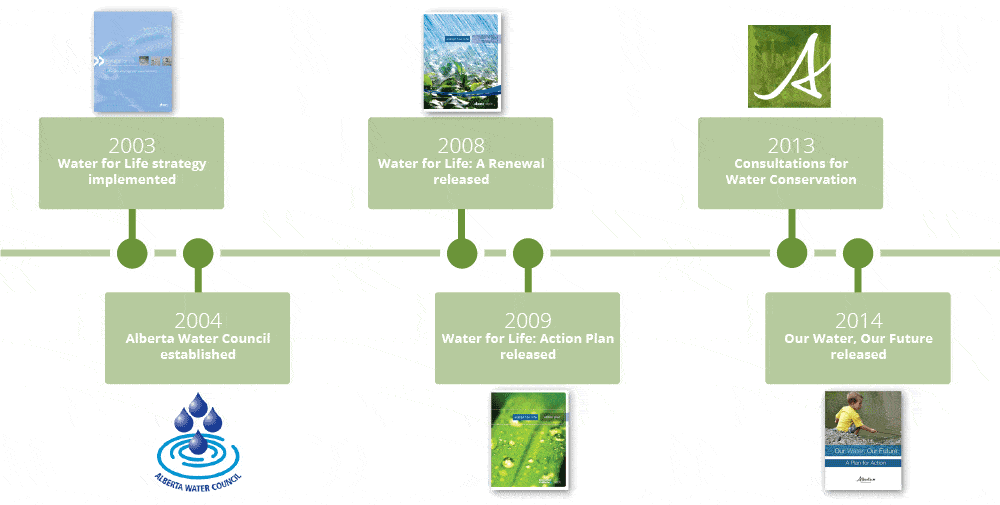
The Water for Life strategy was implemented in 2003 and has been expanded and renewed. In 2004, the Alberta Water Council was established to implement the strategy.
Water for Life was the first of its kind in North America, but the strategy reflects a growing awareness for fair and sustainable water management.
“Canadian attitudes towards water are changing,” lead writer Liane Langstaff wrote in a 2015 article in Mondaq: Sustainability Shift: The Evolution Of Canadian Water Policy.
“Recent droughts and flooding have underscored that despite Canada’s total water riches, these resources are unevenly distributed – with potentially devastating results. Moreover, the recognition that aquatic ecosystems provide useful services to humans (think of the value of wetlands in filtering water or sport-fishing in streams) has changed the way we look at water.”
As Canadians’ views on water have changed, new policies and strategies need to reflect these changes while working within the existing provincial and municipal planning regimes.
Goals and approaches of Water for Life
Water for Life is centred around three goals:
- Safe, secure drinking water
- Healthy aquatic ecosystems
- Reliable, quality water supplies for a sustainable economy
The following approaches were identified to achieve the Water for Life goals:
- Knowledge and research to improve scientific understanding and inform decisions
- Partnerships with citizens, communities, industry and the government
- Water conservation through management plans and conservation practices
To see a breakdown of the goals and key directions, review the 2008 Water for Life Renewal report.
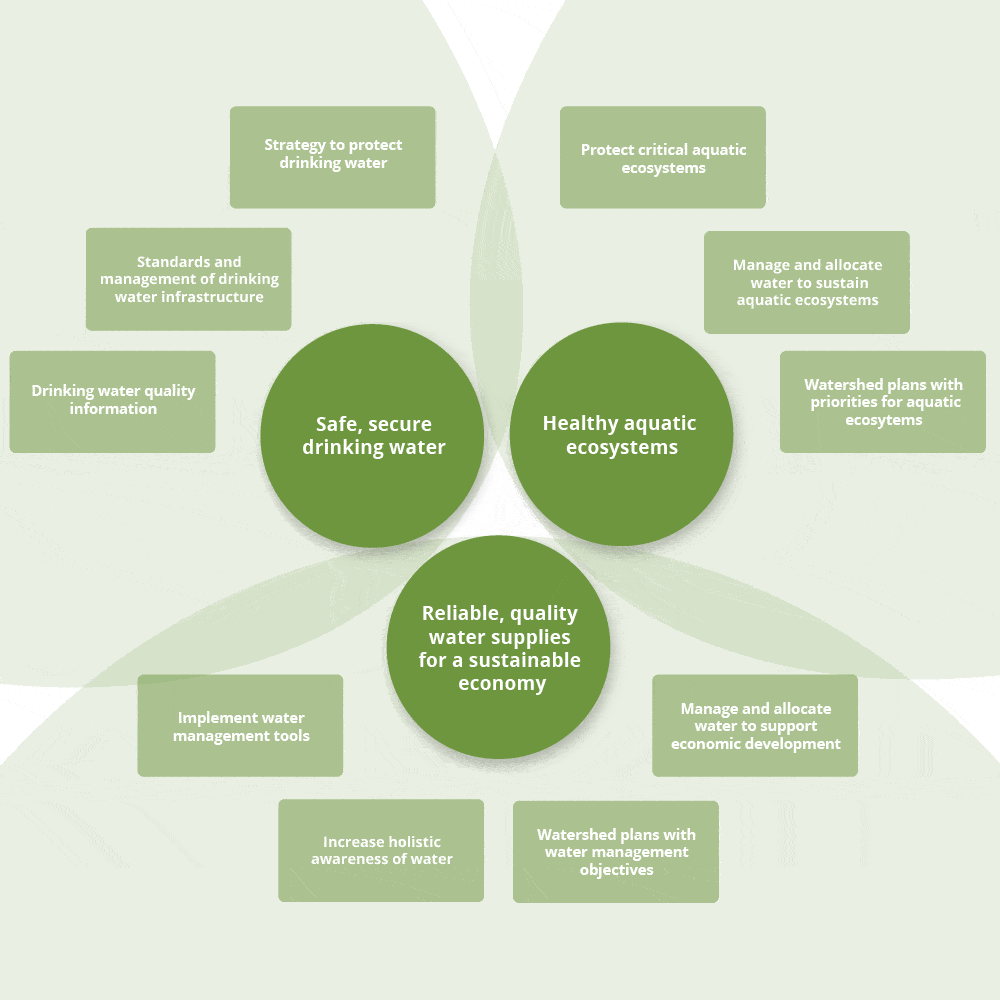
The main goals of Alberta’s Water for Life strategy, from the 2008 Water for Life Renewal report.
How Water for Life fits into regional planning
The impacts of land use on water and aquatic environments is acknowledged in the 2008 Land-use Framework.
“It complements the province’s water and air policies— Water for Life (2003), the Clean Air Strategy for Alberta (1991) both of which have been updated, and Alberta’s 2008 Climate Change Strategy,” states the Land-use Framework. “What uses are permitted on land—or more precisely, how they are done—clearly impact adjacent watersheds and airsheds.”
Alberta’s regional plans recognize the potential for impact on water, but it is difficult to categorize what impacts are the result of a particular use of land.
“The scope of a Land-use Framework is not so easily defined,” continues the document. “Is it about extending water and sewers from towns into adjacent rural communities? Or the proximity of feedlots to populated areas? Or addressing cumulative effects of development on the quality of our air, land and water on a region-by- region basis? Suffice to say, it is a more difficult topic to contain than air and water, and the implementation of the Land-use Framework will entail ongoing public discussion.”
Alberta’s regional plans (most notably the South Saskatchewan Regional Plan) begin to link Water for Life with actionable steps to achieve the desired outcomes within the Water for Life strategy. The approaches identified within the South Saskatchewan Regional Plan were developed with the guidance of Water for Life.
“Alberta has a strong water management system in place,” reads the South Saskatchewan Regional Plan. “Since 2003, the Water for Life strategy has provided a roadmap to achieving provincial goals of a safe, secure drinking water supply; healthy aquatic ecosystems and reliable quality water supplies for a sustainable economy. To fulfill these goals, the strategy revolves around the three key directions of knowledge and research, partnerships and water conservation.”
Two strategies in the South Saskatchewan Regional Plan are founded on the Water for Life strategy:
SSRP Strategy 4.3: Continue to support the work of the Watershed Planning and Advisory Councils on watershed assessment and planning under the Water for Life strategy, in alignment with regional planning. Stakeholders are encouraged to support the work of the Watershed Planning and Advisory Councils including development and implementation of watershed management plans.
SSRP Strategy 4.11: Continue to work towards the targets set within the Water for Life strategy with all sectors demonstrating best management practices to reach overall water efficiency and productivity improvements by 30 per cent from 2005 levels by 2015.
Implementing Water for Life is a community effort
Water for Life is a water management strategy that covers a significant geographical region. To achieve the three goals – safe drinking water, protection of aquatic ecosystems and water management for development – citizens, community groups, municipalities and the provincial government are all invited to participate and contribute. Implementing the Water for Life strategy requires a community effort.
There are three levels of advisory councils:
- Provincial Water Advisory Council: Reviews information and provides recommendations and advice
- Watershed Planning and Advisory Councils (WPACs): Recommendations, collaborations and advice for watershed management
- Watershed Stewardship Groups: “On-the-ground” actions and recommendations for local water management.
To aid in the implementation and evaluation of Water for Life, the Alberta Water Council collaborates with the advisory councils and with the provincial government to monitor and steward the program.
Municipalities are not left out with a role. The Water for Life Action Plan (2009) acknowledges that municipalities contribute to provincial water management but often focus on priority services: access to drinking water and wastewater treatment.
“Alberta’s municipalities are important partners in the effective management of the province’s water resources. However, Alberta’s growth has presented challenges for these partners to provide safe drinking water and environmentally acceptable wastewater. We will address these vulnerabilities by fostering municipal resiliency through sustainable waterworks infrastructure, effective operations, and preparedness.”
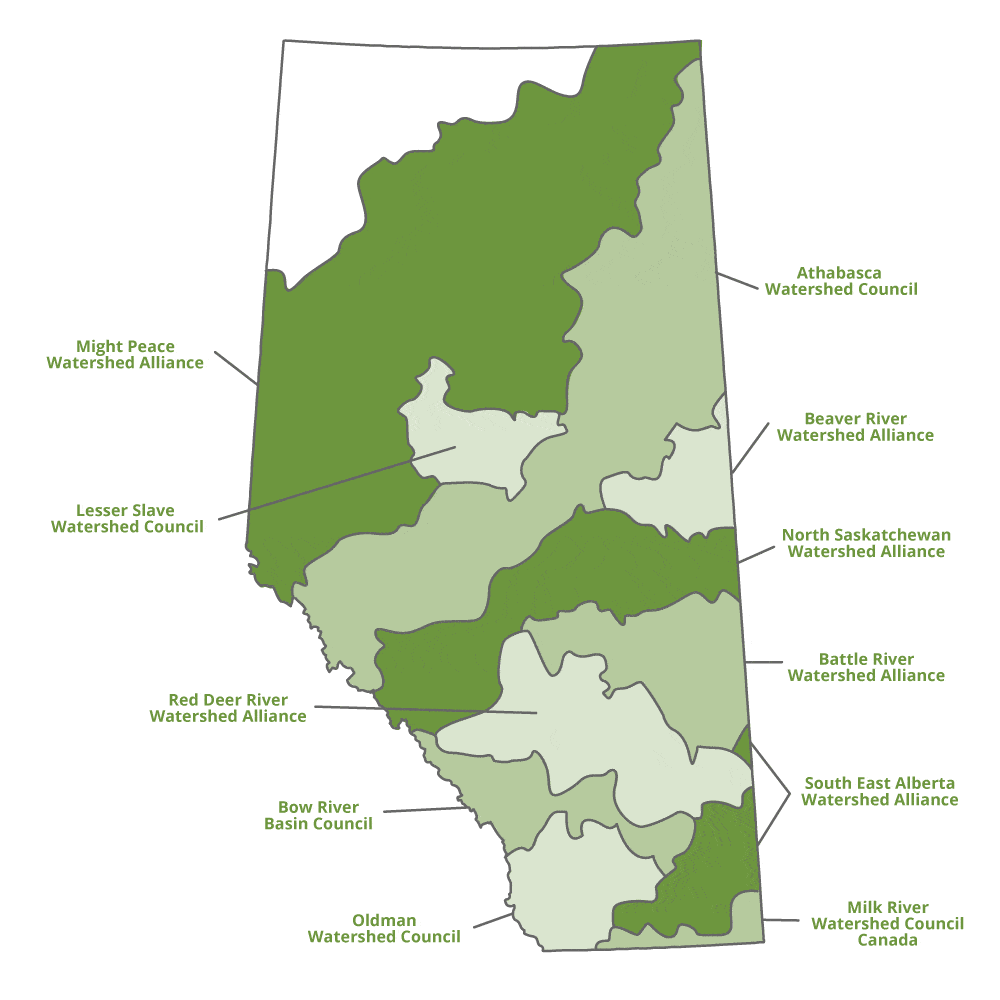
There are 11 Watershed Planning and Advisory Councils (WPACs) in Alberta.
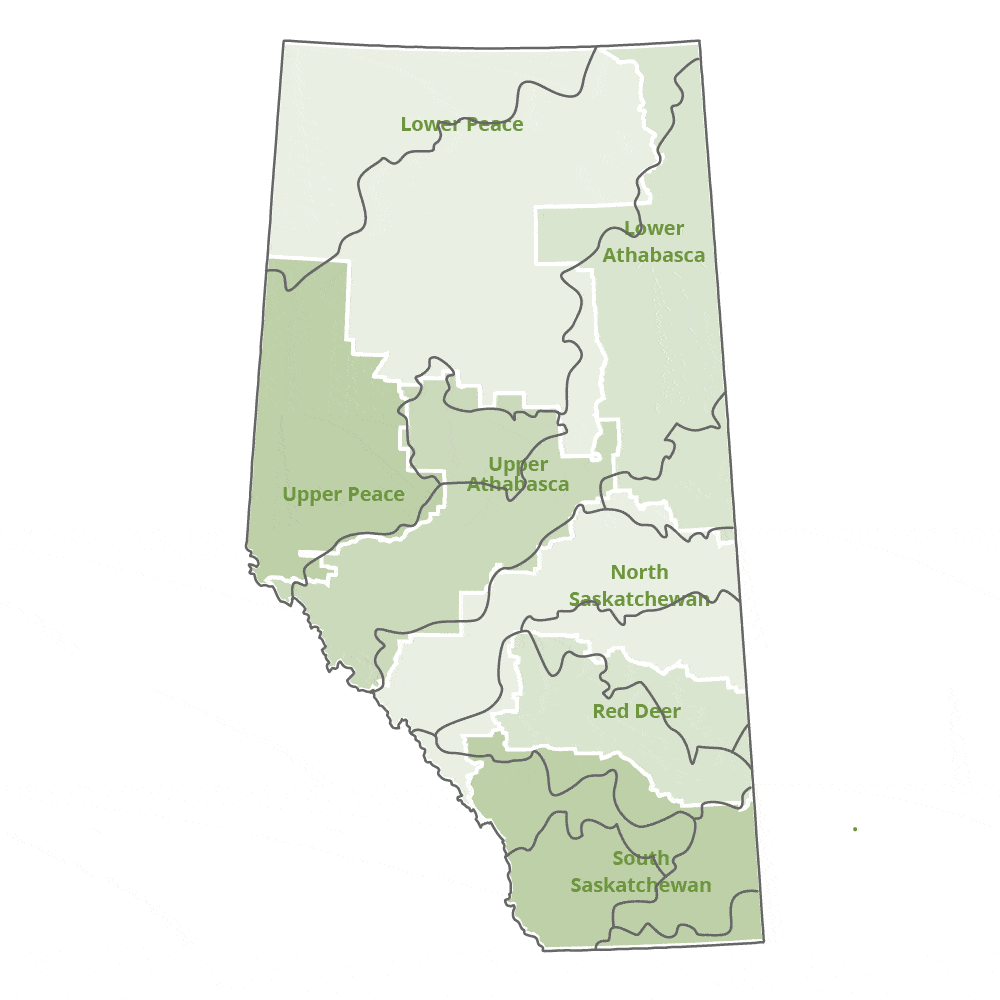
Alberta’s 11 Watershed Planning and Advisory Councils (WPACs) superimposed on the Land-use Framework’s regions.
Water strategies at a municipal level
Not surprisingly, a comprehensive strategy for protecting and managing water in a large geographical region has many layers. There are three main goals, from which 18 actions are derived. Alberta’s municipalities have a direct role in three of those actions.
The following actions relate to Alberta municipalities and are derived from Alberta Water Council’s 2017 report on the progress of implementing Water for Life.
Drinking water and wastewater
Design and implement regional drinking water and wastewater solutions.
Grants are available from the provincial government (administered by Alberta Transportation) for:
- Pipelines for new drinking water and wastewater systems
- Feasibility studies for regional water systems
- Upgrades to water and wastewater treatment facilities
- Pipelines for future extensions
The intention of the grants are to support regional water systems. Applications require at least two municipalities (or regional commissions, municipal partnerships or public-private ventures). Grants cover up to 100 per cent of the project costs.
Learn more and apply for the Regional Water Systems Grant from Alberta Transportation.
Operational capacity for drinking water and wastewater operations
Develop innovative approaches to build and ensure long-term operational capacity in smaller Alberta communities.
A training course for municipalities is available to create systems to assess risk factors of drinking water on an ongoing basis. This system, a drinking water safety plan, ensures that drinking water remains safe and available. The course is available to download – along with templates, frameworks and additional information – from Alberta Environment and Parks.
On the wastewater side, resources are available for maintaining treatment systems through hiring qualified operators and sharing services through consortiums. The Alberta Water and Wastewater Operators Association has resources for municipalities seeking to share operators, hire operators or provide training. Alberta Environment and Parks provides data, guidelines and reports for wastewater and storm water systems. The Alberta Urban Municipalities Associations has compiled a list of existing regional water systems in the province.
Upgrades to water facilities
Facilitate upgrades to drinking water facilities and wastewater facilities to meet standards and, where possible, integrate with regional systems.
Support to meet drinking water and wastewater standards is available from provincial and federal funding. These funds are used to reduce infrastructure deficits, upgrade facilities and create regional systems.
The Alberta Municipal Sustainability Initiative is one program with funding available for water facilities. Grant applications can be submitted through the Alberta Municipal Grants Management Application for the following programs that are relevant to water systems:
- Water for Life – New regional water systems
- Water for Life – Existing regional water systems
- Alberta Municipal Water/Wastewater Partnership
List of Water for Life resources
Drinking Water Safety Plan course and downloads – Government of Alberta
List of Alberta’s Regional Water and Wastewater Systems – Alberta Urban Municipalities Association
List of Alberta’s Watershed Planning and Advisory Councils (WPACs)
List of Alberta’s Watershed Stewardship Groups (WSGs)
Our Water, Our Future: A Conversation with Albertans (2013) – Government of Alberta
Our Water, Our Future: A Plan for Action (2014) – Government of Alberta
Our Water, Our Future: Summary of Discussions (2014) – Government of Alberta
Review of Water for Life Implementation Progress: 2012–2015 (2017) – Alberta Water Council
Urban Municipal Water Conservation, Efficiency and Productivity Plan (2014) – Alberta Urban Municipalities Association
Water Conservation, Efficiency and Productivity Plan (2009) – Alberta Urban Municipalities Association
Water for Life (2003) – Government of Alberta
Water for Life: Current and Future Water Use in Alberta (2007) – Government of Alberta
Water for Life: A Renewal (2008) – Government of Alberta
Water for Life: Action Plan (2009) – Government of Alberta
Water for Life: Fact Sheet (2015) – Government of Alberta
Water Primer and Discussion Paper for Municipalities (2011) – Alberta Urban Municipalities Association
Water Management Policies and Resources for Municipalities – Alberta Urban Municipalities Association
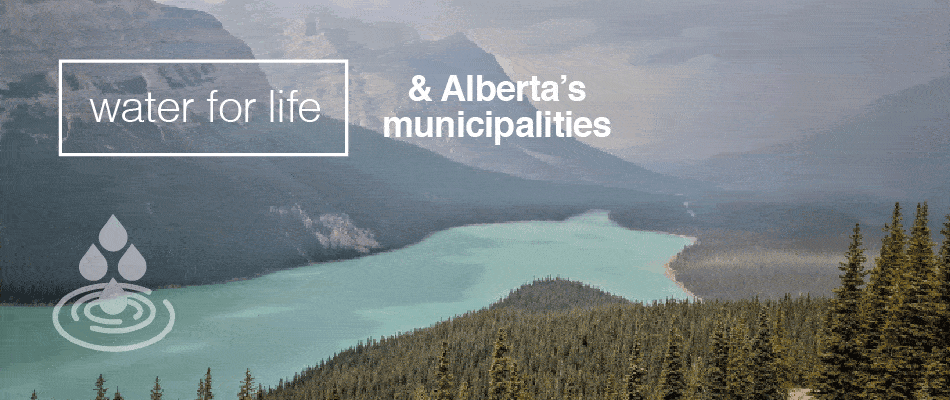
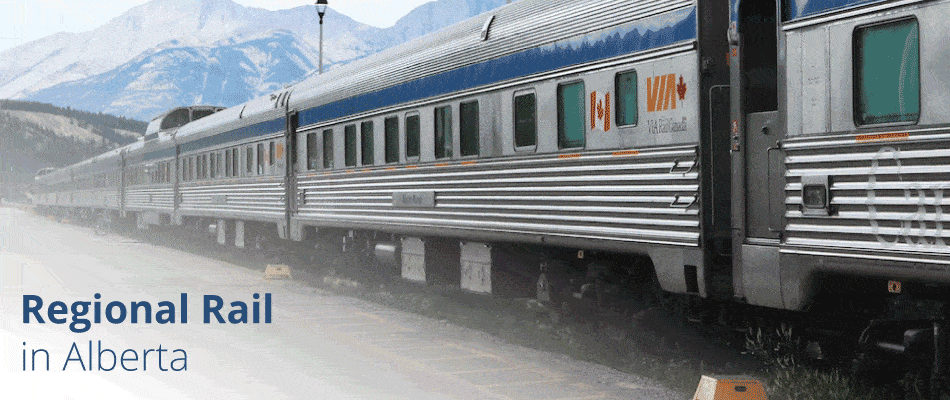
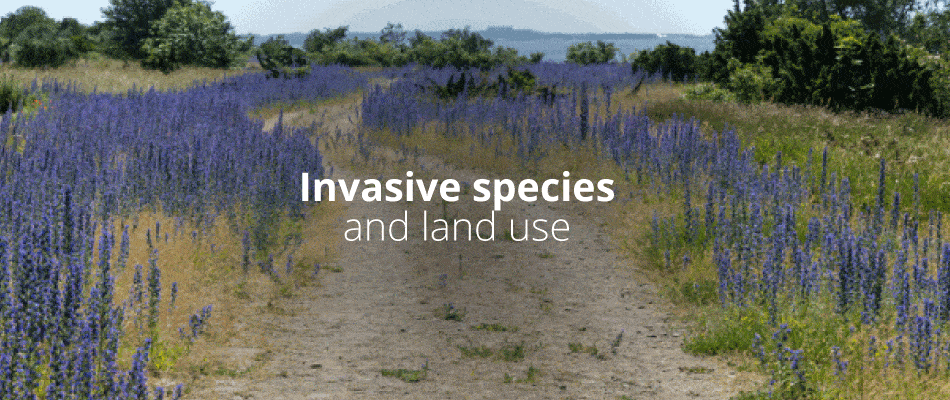

Recent Comments